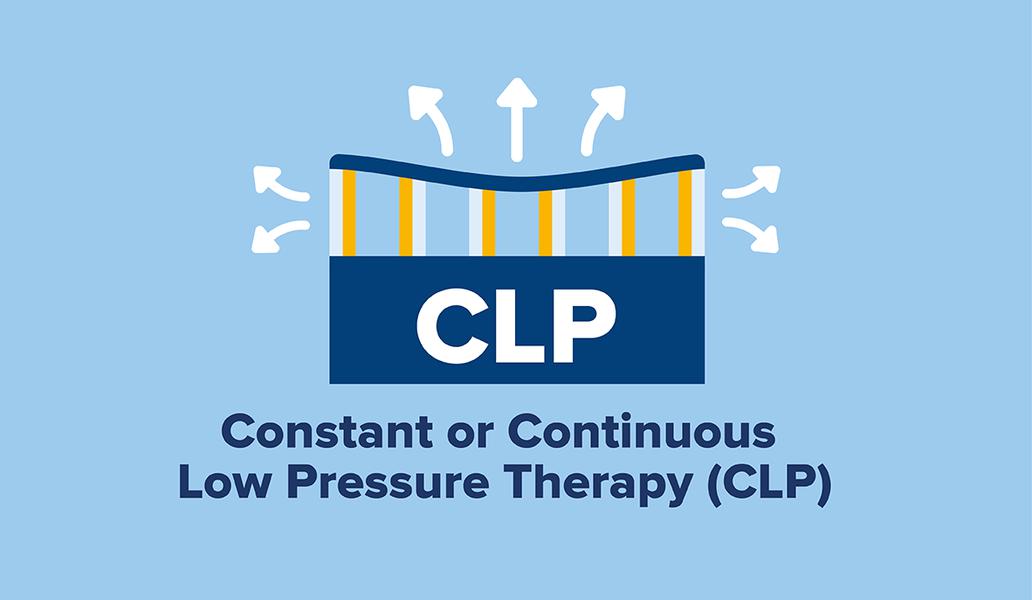
The use of active (alternating) and reactive (constant low pressure) support surfaces help manage the interface pressure applied to the individual, and depending upon the individual needs of the patient, support surfaces can in some instances help reduce the frequency of manual repositioning required.
More advanced mattresses and cushions may be switched between the two modes by incorporating both active and reactive therapies into a single support surface. These products offer all of the pressure relieving qualities of an active support surface with the addition of CLP mode, which is a static mode reducing the pressure exerted on the patient’s skin and subcutaneous tissue.
Often where mattresses have dual or multi therapy modes within them, the mattresses tend to be used in alternating mode only, as there is a distinct lack of understanding as to how and when other modes of therapy such as a reactive CLP therapy mode should and can be used.
Understanding the differences between the various support surfaces and their differing modes of action is an important skill and enables the clinician to provide the most appropriate support surface for their patients, thereby meeting their clinical needs in terms of pressure area care and management.
Previously CLP has been referred to in the context of pressure relieving or pressure reducing therapy, however NPIAP 2018¹ now describe CLP as pressure redistribution, whereby the support surface has the ability to distribute a load over the contact area of the human body.
They also consider CLP to be a reactive support surface with the capability to change its load distribution properties only in response to an applied load.
This is further compounded by Bliss 1993² who states that cushions, beds and mattresses either mould around the shape of the patient to distribute the patient’s weight over a larger contact area (constant low-pressure (CLP) devices); or vary the pressure beneath the patient mechanically, thus reducing the duration of the applied pressure.
How does CLP work?
CLP works by significantly reducing the pressure within the air cells ceases any movement within the mattress, therefore allowing the patient to be immersed and enveloped by the support surface.

McInnes et al 2012¹ state that penetration (sinking) into a support surface, measured by depth.
- Increases patient contact area by sinking more deeply into the support surface
- Lowers interface pressure due to increased denominator
As an individual immerses (sinks) into the support surface, their weight can be redistributed over a larger area therefore reducing the interface pressure between the patient and the support surface International Guidelines 2019³

The ability of a support surface to conform, so to fit or mould around irregularities in the body. Current literature describes CLP as the body immerses (or sinks) into the support surface and is enveloped (or surrounded) by the supporting material¹. This results in an increase in the total surface area over which the body weight is distributed. Distributing the body weight over a larger surface area reduces contact pressures.
- Equalizing loading forces by efficiently moulding to body contours.
- Flattens the “peak to average” ratio (“Peakiness”).
How CLP within a Dual or Multi Therapy Mattress can benefit the Patient
- Promotes comfort for patients who are experiencing difficult pain control especially at end of life
- Where AP therapy is not tolerated in patients with neuromuscular conditions who suffer from muscle spasm
- Promotes better sleeping as there is no movement within the mattress - To enhance comfort, sleep and quality of life, repositioning intervals can often be extended by the use of specialised pressure-redistributing support surfaces. Defloor et al 20054
- Reduces peak pressure points over bony prominences
How Dual or Multi Therapy Mattresses benefit Staff
- Allows them to plan individualised patient care
- Allows for a change of therapy without having to change the mattress
- Therapy adjustments are quick and easy to make
- Avoids unnecessary moving and handling of the patient whilst swapping one mattress for another
- Reduces the financial burden of having to rent a mattress that provides a different therapy mode
For information on the Drive DeVilbiss Healthcare range of Dual and Multi Therapy Mattress Systems, please see here
References
1. McInnes E, Jammali-Blasi A, Bell-Syer S, Dumville J, Cullum N. (2012). Preventing pressure ulcers – are pressure-redistributing support surfaces effective? A Cochrane National Pressure Injury Advisory Panel Support Surface Standards Initiative Terms and Definitions 12/27/2018 Copyright © 2018 NPIAP Page 8 of 8 systematic review and meta-analysis. International Journal of Nursing Studies, 49(3), 345-359
2. Bliss MR. Making Sense of comparative values. Evaluation of trials of constant low pressure supports Professional Nurse 1993 Jun;8(9):564, 566, 568
3. International Guidelines Pressure Injury Advisory Panel. Prevention and Treatment of Pressure Ulcers: Clinical Practice Guidelines 201
4. Defloor T, De Bacquer D, Grypdonck MH. The effect of various combinations of turning and pressure reducing devices on the incidence of pressure ulcers. Int J Nurs Stud 2005 Jan;42(1):37-46.